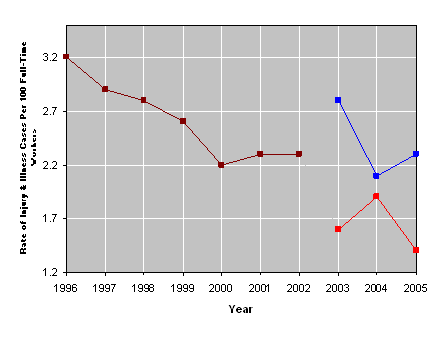All Reported Cases
|
1410
|
Nature of Illness or Injury
Sprains, Strains
Fractures
Cuts, Punctures
Bruises
Heat Burns
Chemical Burns
Amputations
Carpal Tunnel
Tendonitis
Mult Trauma Total
Mult Trauma With Fracture
Mult Trauma With Sprain
Back Pain Total
Back Pain Hurt Back Only
All Other
|
Number
550
180
160
120
20
20
20
N/A
N/A
30
N/A
N/A
70
30
210
|
% Total
39.0
12.8
11.3
8.5
1.4
1.4
1.4
N/A
N/A
2.1
N/A
N/A
5.0
2.1
14.9
|
Part of Body Affected
Head Total
Eyes
Neck
Trunk Total
Trunk Back
Trunk Shoulder
Upper Extremities Total
Upper Extremities Finger
Upper Extremities Hand
Upper Extremities Wrist
Lower Extremities Total
Lower Extremities Knee
Lower Extremities Foot Toe
Body Systems
Multiple Body Parts
All Other Body Parts
|
Number
60
20
N/A
510
290
120
490
280
60
80
290
90
50
20
30
N/A
|
% Total
4.3
1.4
N/A
36.2
20.6
8.5
34.8
19.9
4.3
5.7
20.6
6.4
3.5
1.4
2.1
N/A
|
Source of Injury or Illness
Chem And Chem Products
Containers
Furniture And Fixtures
Machinery
Parts And Materials
Worker Motion
Floors Walkways
Handtools
Vehicle
Health Care Patient
All Other Sources
|
Number
30
140
N/A
190
410
210
160
70
30
N/A
170
|
% Total
2.1
9.9
N/A
13.5
29.1
14.9
11.3
5.0
2.1
N/A
12.1
|
Sex
Men
Women
Sex Not Reported
|
Number
1310
100
N/A
|
% Total
92.9
7.1
N/A
|
Age
Under 14
14 to 15
16 to 19
20 to 24
25 to 34
35 to 44
45 to 54
55 to 64
65 And Over
Not Reported
|
Number
N/A
N/A
N/A
100
310
340
440
190
N/A
20
|
% Total
N/A
N/A
N/A
7.1
22.0
24.1
31.2
13.5
N/A
1.4
|
Race
White
Black
Asian
American Indian or Alaskan Native
Native Hawaiian / Other Pacific Islander
Hispanic or Latino And Others
Multirace
Race Not Reported
|
Number
810
100
N/A
N/A
N/A
210
N/A
210
|
% Total
57.4
7.1
N/A
N/A
N/A
14.9
N/A
14.9
|
Length of Service
Less Than 3 Months
3 to 11 Months
1 to 5 years
More Than 5 Years
Service Not Reported
|
Number
90
180
300
850
N/A
|
% Total
6.4
12.8
21.3
60.3
N/A
|
Days away from work
1 Day
2 Days
3 to 5 Days
6 to 10 Days
11 to 20 Days
21 to 30 Days
31 Days Or More
Median Days Away
|
Number
140
140
170
150
240
100
480
16
|
% Total
9.9
9.9
12.1
10.6
17.0
7.1
34.0
15
|
Event/Exposure Leading to Injury
Total Contact With Objects
Struck By Object
Struck Against Object
Caught In Object
Fall to Lower Level
Fall On Same Level
Slips Or Trips
Overexertion Total
Overexertion In Lifting
Repetitive Motion
Exposure to Harmful Substance
Transportation Accidents
Fires And Explosions
Total Assaults - Violent Acts
Assaults By Person
All Other Assaults
All Other Events
|
Number
550
240
90
170
50
130
50
370
130
50
70
20
N/A
N/A
N/A
N/A
140
|
% Total
39.0
17.0
6.4
12.1
3.5
9.2
3.5
26.2
9.2
3.5
5.0
1.4
N/A
N/A
N/A
N/A
9.9
|






